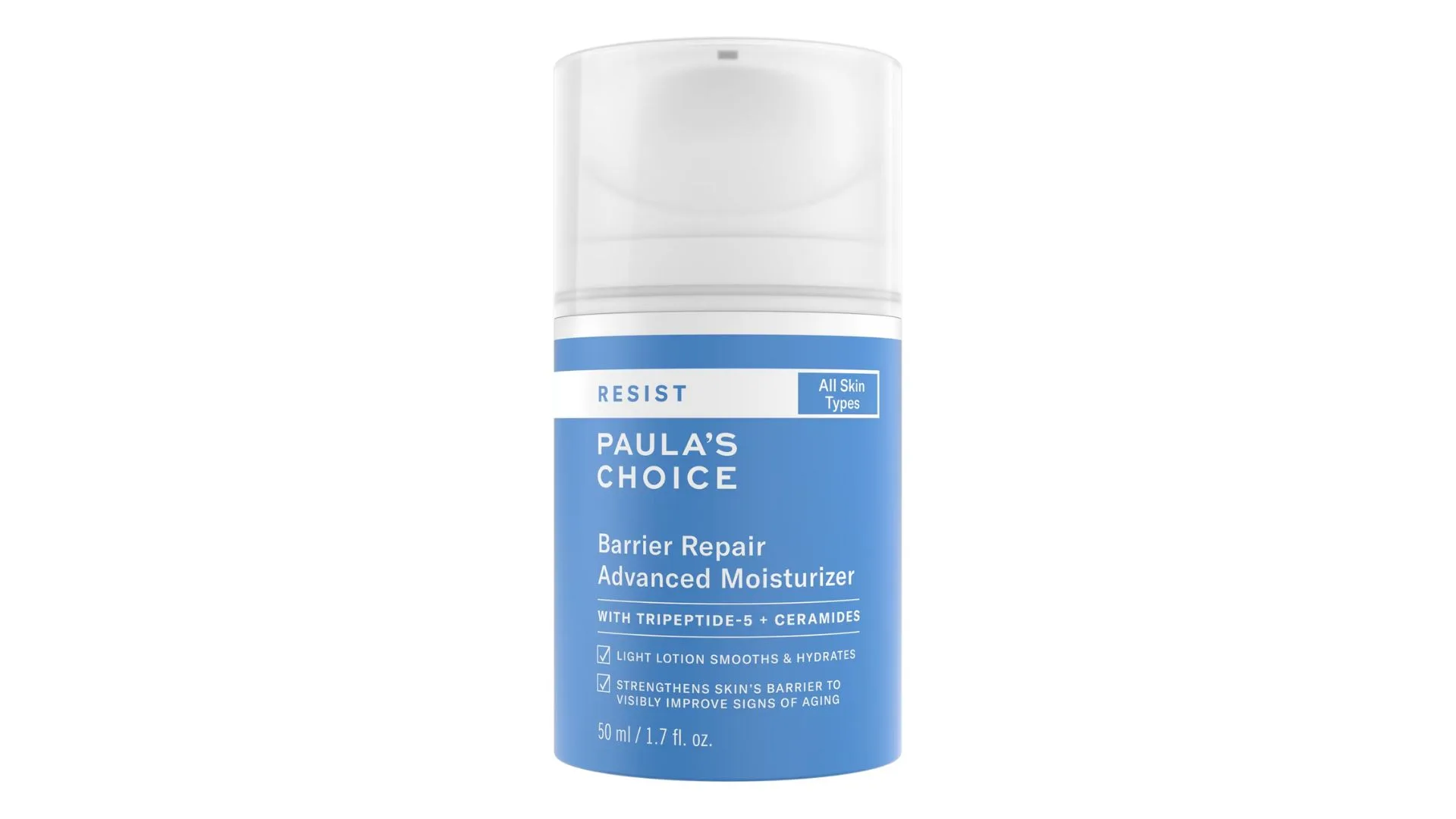Unless you’ve been keeping your distance from social media (which we wouldn’t blame you for), then you’ve likely overheard the term ‘skin barrier’ and how we really should be paying attention to ours.
From dermatologists and aestheticians to skincare savants, it looks as if beauty lovers are no longer building up a 10-step skincare routine—and using every potion and lotion under the sun. Instead, products that offer instant gratification are out the window and taking things back to basics is on the menu.
But why? Well, since the skincare boom, we’ve made it our mission to test out and incorporate every beauty innovation into our routines without truly understanding whether our skin needs them or not. As a result, our skin barrier (otherwise known as the ‘stratum corneum’) has been left in desperate need of some TLC.
A compromised or damaged skin barrier could see your complexion looking inflamed, feeling itchy or even peeling, which leaves most assuming that a new product will fix the problem. But, we’re here to tell you that bringing your routine back to basics may be the trick to repairing your skin once and for all. Essentially, we’re living by the term: less is more.
So, how do we repair our skin barrier? Well, marie claire Australia spoke with Dr Ryan De Cruz, Dermal Therapy brand ambassador and founder of Southern Dermatology Melbourne, on the ways we can protect our skin and keep our complexions as healthy and radiant as possible.
Main image via @patidubroff.

What is a skin barrier and what exactly does it do?
By now, if you’re not familiar with the term then you’re likely desperate to know what our skin barrier even is. Think of it as the layer of skin that we touch, the layer that we apply our copious amount of skincare on.
“Our ‘skin barrier’ is the outermost layer of our skin, composed of skin cells that are held together with a rich cement made up of lipids (oils), cholesterol, moisturising factors, and antibacterial proteins,” Dr De Cruz explains, adding that “it is like the brick wall of a house, whereby the skin cells are the ‘bricks’ and the intercellular lipids are the ‘mortar’”.
While it’s all fine and well that we now understand the concept of skin, in order to really grasp what a skin barrier does, we need to know how it works.
“Our skin barrier protects our skin from dehydration through a process known as ‘transepidermal water loss’ and prevents penetration of bacteria, viruses, dust particles, house dust mite, allergens and irritants,” Dr De Cruz continues. “It ensures our skin and internal organs are protected from environmental stressors and provides thermo-regulation.”
How can I damage my skin barrier and what are the signs of a damaged skin barrier?
But just like every prized possession we hold near and dear, our skin barrier can take on a brunt of damage. And unfortunately, it’s rather easy to do so, thanks to “excessive heat, dryness, mechanical irritation (excessive exfoliation, dermabrasion, chemicals, or clothing), UV radiation, inflammation from skin disease and use of inappropriate skin care”.
For some, a bout of irritated skin might come down to a self-diagnosis of ‘sensitivity’. And while that isn’t entirely untrue, the lines between skin that is prone to irritation from everyday products and skin that reacts to only certain products is blurry.
“A damaged skin barrier may present with signs of ‘sensitive skin’ whereby the skin reacts with redness, burning, itch, irritation, dryness, and flakiness to even the most basic of products,” Dr De Cruz says.
“It is a very common problem and often arises from use of inappropriate chemicals contained in fancy (and often expensive) skin care. Many patients complain of dry, dull, uncomfortable skin, that seems to react to everything they try to soothe it.”

How can I repair my damaged skin barrier?
While understanding exactly what is happening with your irritated skin is only half of the conundrum, the other half is figuring out how to actually fix it—unless you enjoy redness, itching and flaking skin.
According to Dr De Cruz, he believes that the best way to repair a damaged skin barrier is to pack away your extravagant beauty products and reach for the basics instead, until you’re healed.
“The best way to soothe and repair a damaged skin barrier is to use basic, soap-free cleansers that are pH-balanced and rich in the natural lipids that are found in the skin,” he advises.
“Ingredients such as a ceramides, niacinamide, shea butter and colloidal oatmeal have been proven clinically to repair a damaged skin barrier and are found in products, such as the Dermal Therapy eczema range.”
How can I protect my skin barrier for being damaged in the future?
Speaking of protection, while repairing a damaged barrier is essential, it’s just as important to keep your complexion happy all year round.
“Keeping your skin care routine simple and appropriate is the best way to protect our skin barrier. There is no need for a thousand-step routine,” Dr De Cruz says.
He continued, “Simply use a basic, hydrating cleanser, moisturising lotion, or cream, and SPF50+ on a daily basis to keep the skin barrier healthy and intact. Australia’s very own Dermal Therapy have a great range that suit most sensitive skin types and can be applied regularly without causing irritation.”
But of course, if you’re itching (no pun intended) to dust off your favourite ‘active’ skincare product, but are worried about unleashing angry skin, Dr De Cruz advises you to take it one step at a time.
“Any ‘active’ skin care ingredients should be used gently and slowly, and introduced one at a time, to prevent the skin from being over-whelmed,” he explains. “Exfoliation in particular should only be undertaken once or twice per week, with gentle products, in people who genuinely need to exfoliate above the skin’s normal processes (e.g. people who suffer from acne or keratosis pilaris).”
So, there you have it. If your skin has been waking up on the wrong side of the bed for the last little while, it could be that she’s trying to send you a message. And if that’s the case, then it’s time to get repairing.
Best Barrier Repair Creams

01
BUBBLE Level Up Balancing Gel Moisturizer
from $28 at Priceline
New to Aussie shores (the brand launched exclusively to Priceline last week), BUBBLE Skincare have made a splash with their plant based, science-backed simple-but-effective formulas. Their no-frills approach has garnered them somewhat of a cult following amongst Gen Z with an impression 2.7 million followers on TikTok, and cemented themselves as a winner for sensitive or compromised skin. This particular formula is supercharged with Yarrow extract to hydrate and heal, and a superfood protein compound to protect against external aggressors and blue light damage. The ultra light gel consistency feels cooling on the skin and layers well under makeup.

02
Paula’s Choice Barrier Repair Advanced Moisturizer
from $56 at Paula’s Choice
Fast acting, this featherlight formula is clinically proven to improve skin’s barrier in 30 minutes. Impressive. A blend of 5 skin-identical ceramides work to strengthen the barrier and hydrate skin, while a hardworking Palmitoyl tripeptide-5 (synthetic peptide) supports firmness, elasticity and bounce.

03
tbh Rebound Serum
from $ 59.95 at Adore Beauty
Developed with skinfluencer and beauty expert Hannah English (she’s someone you’ll want to take skincare advice from!), the considered formula boasts a harmonious blend of ceramides for barrier reinforcement and Glycerin and Hyaluronic Acid to hydrate. Paired with ingredients like Niacimide, Oat Extract and Green Tea to help reduce redness, calm and smooth over any texture.
/









